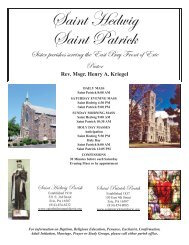March 31, 2013 EASTER SUNDAY - Saint Hedwig Church - Erie, PA
March 31, 2013 EASTER SUNDAY - Saint Hedwig Church - Erie, PA
March 31, 2013 EASTER SUNDAY - Saint Hedwig Church - Erie, PA
Create successful ePaper yourself
Turn your PDF publications into a flip-book with our unique Google optimized e-Paper software.
Today is Easter Sunday and our first<br />
reading during the Easter season will<br />
always come from Acts of the Apostles.<br />
Usually, the first reading is from<br />
the Old Testament with the exception<br />
of the Easter season. Luke ‘s gospel<br />
ends with Jesus ascending to heaven.<br />
He then goes on to write Acts of the Apostles<br />
which begins with Pentecost and traces the early<br />
church. These writings are the only records we<br />
have of the early church and they are invaluable<br />
to us.<br />
Each Easter, the first reading is Peter’s first sermon<br />
to the Gentiles, an extremely important<br />
speech because it contains the core truths of<br />
Christianity. Up until this time, Peter thought his<br />
mission was to the Israelites. However, Peter<br />
had a strange dream in which he was told to<br />
slaughter animals and eat, but he refused saying<br />
he would eat nothing unclean. A voice in the<br />
dream says, “What God has made clean, you are<br />
not to call profane.” Following the dream, servants<br />
come asking him to visit Cornelius, a Gentile.<br />
Peter would not have gone into Cornelius’<br />
house because it was considered unclean, but<br />
based on the dream, he enters and delivers this<br />
sermon to them.<br />
Our second reading comes from Paul’s letter to<br />
the Colossians in which he reminds them that<br />
they were raised with Christ in baptism. This fact<br />
affects the way they live their lives. Remember<br />
that infant baptism would not begin for several<br />
more centuries; only adults were baptized. The<br />
good news that Paul proclaims is that not only is<br />
Christ raised from the dead, but those who are<br />
baptized into Him are also raised from the dead.<br />
Today we read our gospel from John and it is only<br />
in John that “the beloved disciple” appears. He<br />
is not mentioned as being at the tomb in the other<br />
three gospels; in fact, he’s not mentioned at all<br />
in the other three gospels. He is first mentioned<br />
in John at the Last Supper and then remains a<br />
major figure in the post-resurrection appearance<br />
stories. The fact that this person is never named<br />
is John’s way of telling us that the beloved disciple<br />
functions in the story not as a person, but as<br />
a symbol. He symbolizes the importance of having<br />
a loving personal relationship with Jesus<br />
Christ. Note that the beloved disciples gets to the<br />
tomb first but waits for Peter to come. Peter<br />
comes to no conclusion as to what happened but<br />
the beloved disciple enters the tomb and “he saw<br />
and believed.” John is telling us that although authority,<br />
represented by Peter, is important, it is<br />
love that enables a disciple of Christ to believe in<br />
the resurrection.<br />
All of that is consistent with what we’ve been exploring<br />
in our Lenten homilies, ie., how Jesus<br />
dealt with sin, with sinners, with compassion and<br />
with forgiveness. It can all be summed up in his<br />
words to the Pharisee Simon concerning the<br />
woman known to be a sinner. Recall, she stands<br />
behind Jesus, they never exchange a word, she<br />
merely begins to weep so profoundly that she<br />
washes his feet with her tears and anoints his<br />
hair with oil. And Jesus says, “Do you know why<br />
her sins are forgiven? Because of her great love.<br />
Little is forgiven the one who does not love.” And<br />
there lies the totality of this whole gospel event..<br />
Take note today to listen to the bell carillon as we<br />
now have bells again at St. Patrick’s. This carillon<br />
has been donated in memory of Joe Kohler.<br />
The parish office will be closed Easter Monday<br />
and re-open on Tuesday.<br />
During the month of January, the <strong>Saint</strong> Patrick<br />
Food Pantry distributed 32,045 pounds of food to<br />
822 families. Total cost to the parish for January<br />
distribution was $1,417.27. Thank you for the<br />
very generous way you support this ministry. We<br />
have just completed a new floor in the Food Pantry<br />
thanks to a grant from the <strong>Erie</strong> Community<br />
Foundation, and we are now installing a new<br />
door for the entry.<br />
Over the past century there has been a dramatic<br />
shift in Catholicism toward the south. For example,<br />
Europe has a total of 177 million Catholics<br />
while Africa has 177 million and Asia has 137<br />
million Catholics. In North American, the United<br />
States has 71 million Catholics and Canada 15<br />
million, but Latin America has 483 million! So it<br />
would seem only natural that the new pope<br />
would hail from the southern hemisphere. Let us<br />
pray that his holiness and simplicity can permeate<br />
the pompous atmosphere of the Vatican.<br />
Belgium has long been THE Catholic country of<br />
Europe with a flourishing mature faith that went<br />
much deeper than, for example, the piety found<br />
in Ireland. But, like the rest of Europe, the church




